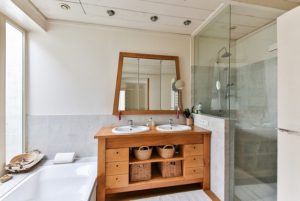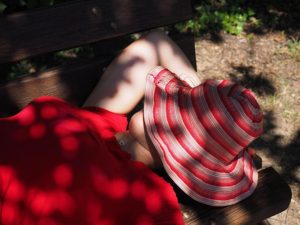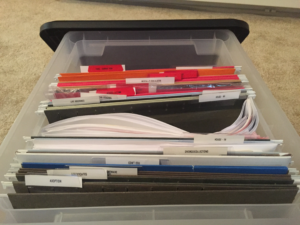by Jayme Radomski | Sep 12, 2017 | Mindfulness, Nesting
 Fall brings a feeling of nesting for us all. The season change, a cold winter ahead, has us planning and preparing. Here are some ideas to help you simplify your fall nesting.
Fall brings a feeling of nesting for us all. The season change, a cold winter ahead, has us planning and preparing. Here are some ideas to help you simplify your fall nesting.
Home
Preparing your home for fall and winter can be an undertaking. Break this project down. First start by putting away summer decorations and activities. This will free up space for you to think about your fall, winter and holiday decorating. It also gives you space for cleaning. Consider items that did not bring enjoyment to you over the summer. Then, drop these items off for donation if you feel they will serve another home better.
Kitchen
Pulling out summer entertaining and outdoor dishes will free up space in your cabinets and countertops. First, clear the pantry of the summer convenience foods. Second, before your next trip to the grocery store (or delivery), empty the refrigerator. Toss items that are expired. Wipe down all shelves and walls of the refrigerator. Lastly, inventory what you have and plan some meals around those items. Jot down some favorite fall meals to make your meal planning a bit easier.
Wardrobe
September might not be the month to do a complete wardrobe changeover, but take some time to pull out the summer clothes that you did not wear, did not like or no longer make you feel great. Box them up and drop them off at a local shelter or consignment shop (to recoup a little of your investment).
Yard
Start to plan what plants will need extra attention before the winter. Arrange for fall clean up if you plan to outsource this. Then recycle and donate toys and furniture you don’t want to see in your yard next summer.
Schedule
Getting into a new schedule can be challenging, especially when you are managing multiple schedules. Don’t expect perfection. A homemade dinner may not be reasonable on an evening full of meetings or activities. Allow for the unexpected and focus on the priorities. Then the rest will fall into place in the coming weeks.
Enjoy the cooler weather. Remember to take your organizing journey one step at a time. In addition, focus on what matters and what will have the biggest impact for you.
by Jayme Radomski | Aug 22, 2017 | Bathroom
 Organizing your bathroom can be fun and rewarding. Make your bathroom a relaxing place to be by following these basic bathroom organizing tips.
Organizing your bathroom can be fun and rewarding. Make your bathroom a relaxing place to be by following these basic bathroom organizing tips.
1. Cleaning
Empty all cabinets and drawers and wipe the surfaces. Hair, dust and residue tend to collect in these areas. Use an essential oil such as tea tree, lemon or orange to disinfect and add a fresh scent.
2. Make Up
When organizing and inventorying your make up combine all make up into one area. Remember to check your desk, purse, suitcase and vanity so all your makeup is inventoried. Dispose any make up that is old and expired. Donate new make up that you know you will not use to a local women’s shelter. Remove any colors that do not suit you anymore. For more great tips on organizing your make up, read more from LeAnn Conway Refresh Your Makeup Bag
3. Towels
To organize your towels follow these simple steps: Gather all bath towels, hand towels, wash clothes, etc. from around your home. Determine a reasonable number of towels per person in your home plus guests. Two bath towels, hand towels and wash clothes per person may be reasonable. Donate extra to a local animal shelter or human society. Fold the towels in a consistent way. There is no magic method to this, just fold them how they will best fit your cabinet or closet.
4. Organize
Now it is time to put all items back into the cabinets. You may want to consider purchasing some organizing supplies now that you know what you have and how you want to store it. Organizing supplies such as drawer dividers, containers, multi-level shelves, hanging shelves, or lazy Susan maybe helpful. Local hardware stores, Bed Bath & Beyond or the Container Store offer great solutions. When organizing remember to only keep what you love and need, keep like items together and find a space that fits your stuff.
If organizing your bathroom seem overwhelming, a professional organizer can help. See if Top Shelf Home Organizing can help you on your journey. Contact Jayme to schedule a consult or chat about organizing.
by Jayme Radomski | Aug 15, 2017 | Self Care, Bathroom
 Are you spending too much money? Working too many hours? Doing too many things at one time and not paying attention to what (who) matters most? This month is the time to refocus on you, who you are and what you are grateful for. Here are a couple ideas on self care to get you refocused.
Are you spending too much money? Working too many hours? Doing too many things at one time and not paying attention to what (who) matters most? This month is the time to refocus on you, who you are and what you are grateful for. Here are a couple ideas on self care to get you refocused.
1. Reset
Rest is not negotiable when it comes to your well-being. When is the last time you felt well rested for a solid week or even a couple days? Not being well rested makes your body out of sync. Your appetite soars and you become short fused. These feelings are not good for you and the people you love. Build your schedule and routine around a day of rest. Set aside a full day to do nothing, disconnect and just be. It will make the rest of your week more productive and your relationships stronger.
2. Disconnect
Learning how to be alone and disconnect helps us connect with others. Constantly checking emails, social media feeds and other messages gives us the feeling of being connected when in reality we are alone. Being glued to the phone while the kids are playing at the park disconnects you from watching, growing and learning from your kids. Times of awkwardness at a social gathering or avoiding small talk with someone new causing you to pull out your phone so you appear to be busy is a distraction that leaves you in a state of loneliness. Learning how to be without connection to the world for a day, a couple hours, or just while waiting in a line somewhere will help you rejuvenate, focus on what relationships matter and be the best you.
3. Simplify
Self-care is challenging when you are drowning in stuff, lists and schedules. Self-care is taking care of your soul, not your stuff. Simplifying your schedule, saying no to opportunities, and reducing the stuff you own, frees your mind to focus on your well-being. Respecting your time is doing something right, not necessarily 10 things efficiently, but half-heartedly. Recognizing a habit, idea or a place that is no working for you is a start to self-care. Clear off your desk or declutter your bedroom and recognize how it makes you feel. Say ‘No’ to an opportunity and recognize when a relationship is not fitting to you. Take a mental note of how it frees your mind. Forget about keeping up and make a point to have, do and schedule what is best for you.
4. Take Care of You
Caring for your body is the most important factor in self-care. Caring for your well-being pulls all of the self-care ideas together. You are in complete control of what you do to your body from food to exercise. Choose exercise that is fitting for you; something that you can maintain, is sustainable and is easy for you to do. Improve your diet by making simple changes. Add some vegetables to your morning smoothie, think about whether you need that second cup of coffee, drink water and talk back to cravings.
by Jayme Radomski | Jul 25, 2017 | Digital, Money & Paper Management
 Unmanaged paperwork around your home and office can be quite stressful. Searching for important documents may seem hopeless. Interest charges and late fees can pile up quickly on misplaced bills. Deadlines are easily overlooked. Getting on top of your papers and developing a good paper management system will reduce your stress.
Unmanaged paperwork around your home and office can be quite stressful. Searching for important documents may seem hopeless. Interest charges and late fees can pile up quickly on misplaced bills. Deadlines are easily overlooked. Getting on top of your papers and developing a good paper management system will reduce your stress.
Choose a Convenient Location
Where you manage your paperwork should be convenient. Going to a secluded area of your home may not encourage you to manage your paperwork. If it is not an area you enjoy being in, you won’t go there.
The workspace should have ample surface area, basic office supplies (envelopes, pens, address label), computer and printer, paper recycle bin and paper shredder.
Remove the Unnecessary, Immediately
Sort your mail as soon as it comes in with a recycle bin and shredder within in arm’s reach. Junk mail should be recycled immediately. Refer to the document retention guideline for guidance on what documents to keep and for how long.
Do Initial Sorting
Create a temporary, simple filing system for the initial sorting of your paperwork. This file system could include files labeled:
File – for files to be filed
Pay – for bills to be paid
To Do – for items that require attention within the next month
Read – for documents that will required your dedicated attention
Regularly go through and Pay, Sort and File
Set up a weekly time to go through the temporary files. Coordinate your bill paying with your pay dates. File papers from the ‘file’ file. Review your ‘to do’ file for items needing attention within the next week. Take some time read through the files from your ‘read’ file.
Choose Physical or Electronic Files
Decide if you prefer physical or electronic files. It’s nearly impossible to completely do one or the other, but designating one or the other as your filing system will help to manage your paperwork.
It is important to always be aware of what papers, documents and receipts enter your home. Receipts can be sent via email or not retained at all. Be selective of what documents are collected at trade shows, conventions and seminars. Only accept the documents that are relevant to you. Be mindful of the mailing lists, marketing emails and promotional lists you sign up for.
Once your paperwork system is set up, plan to set aside time every week to maintain and manage your paperwork. Staying on top of your system will reduce stress and ensure you keep on top of your work and bills.
If setting up a paperwork management system is overwhelming for you, a professional organizer can help. Contact Jayme with Top Shelf Home Organizing for a consultation to see how we can help.
by Jayme Radomski | Jul 13, 2017 | Digital, Money & Paper Management
 Are your filing drawers overflowing? Do you have several stacks of paper documents with no idea as to which you need and which belong in the trash? Are you overly concerned that the IRS will come knocking at your door and you won’t have something you need? Your stress is over. This checklist on how long to keep all your financial and other important documents will help guide you!
Are your filing drawers overflowing? Do you have several stacks of paper documents with no idea as to which you need and which belong in the trash? Are you overly concerned that the IRS will come knocking at your door and you won’t have something you need? Your stress is over. This checklist on how long to keep all your financial and other important documents will help guide you!
Documents to Keep Forever
- Income tax returns
- CPA audit reports
- Deeds, mortgages and bills of sale
- Legal documents (wills, living wills, power of attorney designation, medical and burial instructions, beneficiary documents)
- Vital records (birth, death, marriage, divorce, adoption)
- Investment trade confirmations and statements that indicate buying and selling, retirement and pension records, year-end statement for investments
- Trust documents
- Receipts for warranties
- Automobile titles
- Current insurance policies
- Medical records
- Education records
- Important correspondence
- Property records (keep until sale of property)
- Car records (keep until sale of car)
- Insurance policies (keep for life of policy)
Documents to Keep for 7 Years
The IRS may go back 7 years to audit your tax returns for errors or incorrectly claimed deductions – so it’s important that you keep all tax-related documents for that length of time.
- Bank records
- W-2 and 1099 forms
- Receipts for tax purposes
- Personnel and payroll records
- Cancelled checks
- Disability records
- Unemployment benefit records
- Settled accident claims
- Mortgages, deeds, leases on sold property
- Records on sold stocks and bonds
Documents to Keep for 1 Year
It’s rare that anyone is going to want to see an electric bill or credit card statement dating back more than a year. But you may choose to keep the following NON-TAX-RELATED papers:
- Checkbook ledgers
- Paycheck stubs (keep until reconciled with W-2)
- Monthly financial statements
- Monthly mortgage statements
- Credit card statements
- Utility records
- Medical bills (in case of insurance disputes)
Documents to Keep Less Than 1 Year
There are always those papers that don’t fit into any of these categories. Retain these records according to the following guidelines:
- Credit card receipts (keep until reconciled on your credit card statement)
- ATM and deposit slips (keep until reconciled on your bank statement)
- Bills (keep until the payment verified on the next bill)
Now, it’s time to simplify!
Now that you know the guidelines on how long to keep all of your documents, it’s time to get organized. Start cleaning out those file cabinets or sorting through those paper stacks that are taking up space and causing you stress.
*NOTE: This checklist is a guideline. Please be sure to consult your accountant and/or the IRS for the most up-to-date rules.
If you don’t have the time to get your business and personal documents organized, Top Shelf Home Organizing would love to help. Call Jayme: 262-373-9416.
 Fall brings a feeling of nesting for us all. The season change, a cold winter ahead, has us planning and preparing. Here are some ideas to help you simplify your fall nesting.
Fall brings a feeling of nesting for us all. The season change, a cold winter ahead, has us planning and preparing. Here are some ideas to help you simplify your fall nesting.



